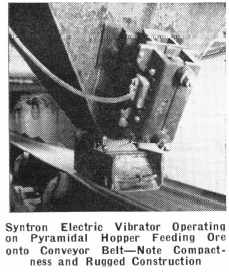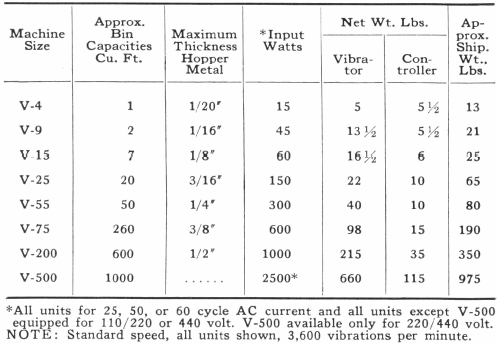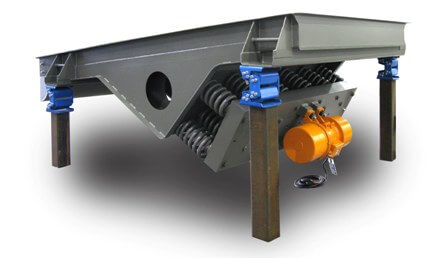Table of Contents
Electric Vibrating Feeder
The Electric Vibratory Feeder is a vibrator that provides an extremely efficient, simple and economical solution to the problem of making the most stubborn material flow freely. No longer need there be a sticking together of wet ore in the ore bin, or the arching over and hanging up of materials in hoppers and chutes with resulting lowered operating efficiency.

The powerful vibration of the simple, electro-magnetic vibrator is controlled by a separate, wall-mounted “Controller,” which is furnished with each vibrator. The dial rheostat in the controller varies the power of vibration. By merely turning the manual dial rheostat the power of vibration can be turned down to provide the most effective vibration required for the purpose. The controller is in a separate, dust-proof housing, arranged for wall-mounting at any desirable distance away from the vibrating mechanism attached to the bin, hopper, or chute.
These vibrators are furnished in many different sizes. Units are available that range from those equipped to handle large tonnages in ore bins down to the small noiseless model best suited to be attached to a dry reagent feeder. Reagent feeder applications are numerous, but a well-known use is where the vibrator is utilized to keep moist lime or soda-ash stirred up and flowing evenly.
In an ore bin with a flat bottom and a center discharge, the material, especially when wet, will build up in the corners and form a dead storage space just inside the walls of the bin. One or two vibrators mounted on the outside of the ore bin (opposite to each other, when two are used), will eliminate the work that otherwise frequently has to be done by hand with a pick and shovel. Another, and possibly more important aspect, is that maximum treatment efficiency is assured by an even feed to crushers or ball mills.
This small, inexpensive unit will save man-hours, assure a smooth running mill through providing an even feed, and will pay for itself in the first few months of its operation.
These vibrators are also available at extra cost with totally-enclosed explosion-proof, or water and dust-proof cases. Also, for special jobs where danger of explosion or fire exists, a water or air-pressure vibrator can be furnished. A major advantage of these hydraulic vibrators over electric vibrators is that they can be made to run at a slow speed as well as at a high speed (2400 to 4800 vibrations per minute).
Vibrating Feeder Capacity
Electric Vibratory Feeder Capacity Formula
q = W x D x δ x v/4800, tons per hour
where q = capacity of the feeder, tph
W = tray width, in.
D = material depth, in.
δ = density of the material, lb/cu ft
v = material flow velocity, ft/min
The flow velocity depends on the method for loading the feeder—is it fed through a hopper? The velocity is also dependent on the material characteristics, size distribution and moisture content, as well as the slope of the feeder. The only way to determine the value for v is by actual observation and then the feeding rate may vary considerably.
